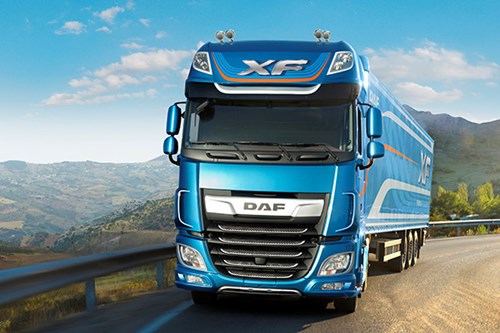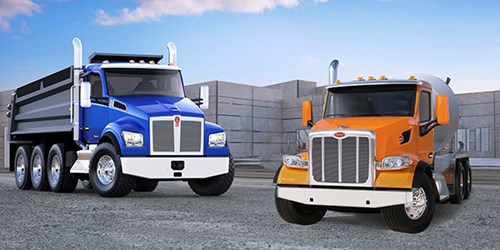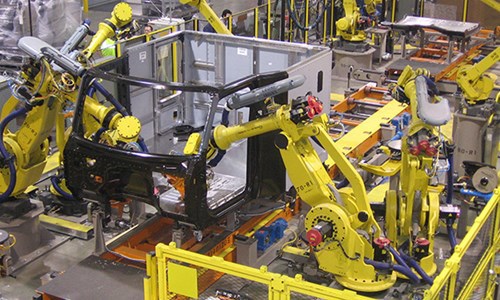PACCAR Achieves Good First Quarter Revenues and Profits
April 25, 2017, Bellevue, Washington – “PACCAR reported good revenues and net income for the first quarter of 2017,” said Ron Armstrong, chief executive officer. “PACCAR benefited from increasing truck production in North America and Europe, as well as record quarterly PACCAR Parts pretax profits. I am very proud of our 23,000 employees who have delivered industry leading products and services to our customers.”
First quarter 2017 net sales and financial services revenues were $4.24 billion compared to $4.30 billion for the first quarter of 2016. PACCAR earned net income of $310.3 million ($.88 per diluted share) in the first quarter of this year compared to a net loss of $594.6 million ($1.69 per diluted share) in the same period last year. PACCAR earned adjusted net income (non-GAAP)1 of $348.0 million ($.99 per diluted share) in the first quarter of 2016, excluding a $942.6 million non-recurring charge for a European Commission (EC) settlement.
Ron Armstrong added, “PACCAR’s strong balance sheet and positive operating cash flow, which has averaged $2.3 billion per year in the last five years, have enabled the company to invest $3.1 billion in new facilities, products and services during the same period. New Kenworth, Peterbilt and DAF vehicles, an expanded PACCAR engine range, innovative PACCAR Parts aftermarket programs, advanced driver assistance systems (ADAS), and PACCAR Financial Services mobile applications are contributing to the company’s long-term growth.”
Highlights – First Quarter 2017
Highlights of PACCAR’s financial results during the first quarter of 2017 include:
- Consolidated net sales and revenues of $4.24 billion.
- Net income of $310.3 million.
- Truck, Parts and Other gross margin of 14.1%.
- PACCAR Parts revenues of $786.7 million and record pretax profits of $151.7 million.
- Cash generated from operations of $610.5 million.
- Research and development expenses of $61.0 million.
- Manufacturing cash and marketable securities of $2.89 billion.
- Stockholders’ equity of $7.08 billion.
Global Truck Markets
DAF’s above 16-tonne truck orders increased 12 percent in the first quarter of 2017 compared to the same period last year. “Our customers recognize DAF’s excellent product quality, low operating costs and strong resale value,” said Preston Feight, DAF president and PACCAR vice president. “We’ve increased our estimate of 2017 European truck industry registrations in the above 16-tonne truck segment to a range of 270,000-300,000 vehicles.”
DAF recently introduced their new 2017 XF and CF trucks at the Commercial Vehicle Show in Birmingham, U.K. These excellent new vehicles incorporate advanced aerodynamics, enhanced powertrain performance and lightweight materials to provide customers with up to seven percent greater fuel efficiency. Sophisticated computational fluid dynamics tools were used to optimize the new trucks’ aerodynamic performance. The PACCAR MX-13 and MX-11 engines have higher efficiency combustion, turbocharging and aftertreatment systems that are electronically integrated with the new automated 12 speed transmission to optimize performance at lower engine speeds. The PACCAR MX-13 engine offers new power ratings that provide up to 530-hp and 1,900 lb-ft of torque.

Model Year 2017 DAF XF Truck
“U.S. and Canada Class 8 truck industry orders were 40 percent higher in the first quarter of 2017 compared to the same period last year,” said Darrin Siver, PACCAR senior vice president. “The truck market reflects the good economy and steady freight demand. Peterbilt and Kenworth achieved 32 percent share of U.S. and Canada Class 8 truck industry orders in the first quarter this year. Class 8 truck industry retail sales for the U.S. and Canada in 2017 are expected to be in a range of 190,000-220,000 vehicles.
Peterbilt and Kenworth Launch Updated Vocational Trucks
Kenworth and Peterbilt recently introduced set-forward front axle (SFFA) vocational models. The durable and reliable Kenworth T880S and the Peterbilt Model 567 SFFA trucks are designed to optimize weight distribution and maximize payload in construction, concrete mixer and other applications supporting infrastructure investments. The Kenworth T880S and Peterbilt Model 567 are powered by the PACCAR MX-13 engine with up to 510-hp and 1,850 lb-ft of torque, or the PACCAR MX-11 engine providing up to 430-hp and 1,650 lb-ft of torque.
“Kenworth and Peterbilt have an excellent history of leading the vocational truck segment. The new Kenworth T880S and Peterbilt Model 567 enhance this legacy and provide customers with a breadth of configurations designed for their specific applications,” said Gary Moore, PACCAR executive vice president.

Kenworth T880S and Peterbilt Model 567 SFFA Vocational Trucks
Peterbilt, Kenworth and DAF Dealers Invest in Global Growth
Peterbilt, Kenworth and DAF dealers have invested over $1 billion and have added nearly 200 locations during the last five years to enhance customer service in North America and Europe. “PACCAR MX engines have increased the aftermarket business opportunity for PACCAR dealers,” noted Harrie Schippers, PACCAR executive vice president and chief financial officer. “The network expansion delivers industry-leading service, enhanced parts availability and excellent operating efficiency for Peterbilt, Kenworth and DAF customers. These investments support PACCAR’s truck and parts market share growth.”
PACCAR Parts Achieves Record Profitability
PACCAR Parts’ 17 parts distribution centers support over 2,100 DAF, Kenworth and Peterbilt dealer service locations. PACCAR Parts achieved record quarterly pretax income of $151.7 million in the first quarter of 2017, which was 13 percent higher than the $134.6 million earned in the same period last year. PACCAR Parts generated revenues of $786.7 million in the first quarter of 2017, nine percent higher than the $719.5 million reported in the same period last year.
“PACCAR Parts has achieved eight percent average annual sales growth over the last 15 years. This superb performance has been driven by ongoing investments in PACCAR Parts and dealer facilities, expanded PACCAR-branded and TRP product lines, and an increased number of PACCAR trucks and engines in operation,” said David Danforth, PACCAR Parts general manager and PACCAR vice president.
Financial Services Companies Achieve Good Results
PACCAR Financial Services (PFS) has a portfolio of 178,000 trucks and trailers, with total assets of $12.27 billion. PACCAR Leasing, a major full-service truck leasing company in North America and Europe with a fleet of 37,000 vehicles, is included in this segment. PFS’ first quarter 2017 pretax income was $57.3 million compared to $80.3 million earned in the first quarter of 2016. PFS achieved first quarter 2017 revenues of $302.2 million compared to $289.4 million in 2016. “PFS’ portfolio performed well during the first quarter of 2017.” said Bob Bengston, PACCAR senior vice president. “The industry’s lower used truck values in the U.S. and Canada impacted PFS’ quarterly results. Used truck demand is increasing and prices have stabilized.” PACCAR’s strong balance sheet, complemented by its A+/A1 credit ratings, enables PFS to offer competitive retail financing to Kenworth, Peterbilt and DAF dealers and customers in 24 countries on four continents.
PACCAR Financial Corp. (PFC) recently opened a new truck remarketing center in Minooka, Illinois, near Chicago. The new facility complements PFC’s truck remarketing centers in Salt Lake City, Utah and Spartanburg, South Carolina. “Kenworth and Peterbilt pre-owned trucks sell at a premium price compared to similar competitor models,” Todd Hubbard, PFC president, commented. “Our portfolio of Kenworth and Peterbilt trucks reflects the popularity of PFC’s excellent truck leasing and financial products.”
Capital Investments and Research and Development
PACCAR’s excellent long-term profits, strong balance sheet, and intense focus on quality, technology and productivity have enabled the company to invest $6.2 billion in world-class facilities, innovative products and new technologies during the past decade. “In 2017, capital expenditures of $375-$425 million and research and development expenses of $250-$280 million are targeted for truck and powertrain product development, enhanced manufacturing facilities and aftermarket support programs,” commented George West, PACCAR vice president.
Peterbilt Motors recently completed construction of a 102,000 square-foot expansion to its truck manufacturing facility in Denton, Texas. “The new, state-of-the-art test and logistics center will streamline vehicle delivery and enhance manufacturing efficiency and capacity,” said
Kyle Quinn, Peterbilt general manager and PACCAR senior vice president. “Peterbilt plans to install additional robotic cab assembly equipment to increase production capacity of its industry-leading Model 579 and Model 567 trucks.”

Peterbilt’s Denton, Texas Factory Robotic Cab Assembly Equipment
PACCAR is a global technology leader in the design, manufacture and customer support of high-quality light-, medium- and heavy-duty trucks under the Kenworth, Peterbilt and DAF nameplates. PACCAR also designs and manufactures advanced diesel engines, provides financial services and information technology, and distributes truck parts related to its principal business.
PACCAR will hold a conference call with securities analysts to discuss first quarter earnings on April 25, 2017, at 8:00 a.m. Pacific time. Interested parties may listen to the call by selecting “Q1 Earnings Webcast” at PACCAR’s homepage. The Webcast will be available on a recorded basis through May 2, 2017. PACCAR shares are traded on the Nasdaq Global Select Market, symbol PCAR. Its homepage is www.paccar.com.
This release contains “forward-looking statements” within the meaning of the Private Securities Litigation Reform Act. These statements are based on management’s current expectations and are subject to uncertainty and changes in circumstances. Actual results may differ materially from those included in these statements due to a variety of factors. More information about these factors is contained in PACCAR’s filings with the Securities and Exchange Commission.
PACCAR Q1 2017 Earnings Statement



